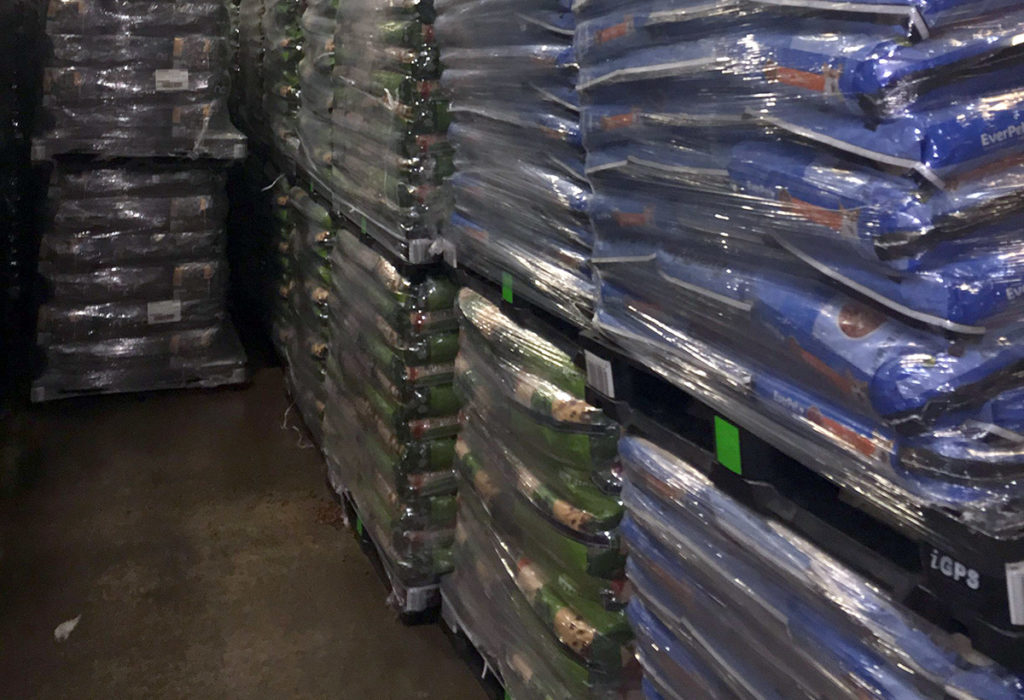Albertsons’ Pallet Requirements
With over 2,252 stores, Albertsons is the nation’s second-largest grocery retailer by number of locations after Kroger. Through its own stores as well as its ownership of the Safeway brand and subsidiaries, it has a truly nationwide reach. Vendors looking to bring their brands to a national market may want to familiarize themselves with Albertsons’ pallet requirements.

Albertsons’ Pallet Requirements and Policies
Like most grocery stores, Albertsons requires a pallet that meets Consumer Brands Association (CBA) specifications (formerly GMA). Albertsons also assesses fines for pallets that do not meet its standards. Every pallet is inspected at its reception point to ensure that it meets Albertsons’ pallet requirements and, if it does not, compliance fees may be assessed. In addition to these fees, the grocery chain will also charge a repalletization fee to shift products from an unacceptable pallet to a shipping platform that does meet Albertsons’ pallet requirements.
All white wood pallets and their constituent parts must meet the criteria below. Suppliers are encouraged to confirm this information directly with Albertson’s to ensure it includes the latest updates.
- Stringers: There must be 3 stringers that are 48 inches in length, at least 1¼ inch in width and 3.5 inches in height. They must be notched to allow for four-way entry.
- Top Edge Boards: Both top edge boards must be present and must be 40 inches in length, ⅝ inches thick, and between 3.5 and 5.5 inches wide.
- Bottom Edge Boards: Both bottom edge boards must be present, and meet the same requirements as the top edge boards.
- Top Interior Deck Boards: There must be 5 top deck boards on the pallet that are 40 inches in length, ⅝ inch thick, and 3.5 inches wide.
- Bottom Interior Deck Board: The must be at least 3 bottom deck boards that meet the same requirements as the top deck boards.
In addition to these specific requirements for white wood pallets, all wood pallets, whether stringer or pooled block pallets, must meet the following standards:
- Protruding fasteners cannot be present on the top, bottom, or sides of the pallet. All nails must be driven flush.
- Contamination of grease, chemicals, or any substance that could soil the product or the shipping container is not allowed.
- Stringers must not be doubled, blocked, patched, or have companion stringers.
- No top or bottom deck boards may be broken.
- Boards cannot be missing from the top or bottom deck of the pallet.
- All top and bottom boards must be securely attached to the stringers.
- Top and bottom edge boards must be flush with the edges of the stringers.
Pooled pallets must belong to the rental pools of CHEP, PECO, or iGPS. In addition to these pallet requirements, Albertsons does not participate in pallet exchange programs and will not provide payment, credit, or pallet returns in exchange for white wood pallets. Vendors looking to avoid fees and the responsibility of transporting and maintaining their own pallets should therefore consider using pooled plastic pallets.

Using Plastic Pallets to Meet Albertsons’ Expectations
Wood pallets with loose fasteners, broken boards, and soiled pallets are all common issues that are also explicitly prohibited by Albertsons. Wood boards routinely break during loading and handling in the supply chain, and it is common for wood pallets to become soiled due to product spills, grease from supply chain equipment, and dirt and debris from loading docks and transportation containers.
Loose fasteners, missing boards, and debris are nonexistent with plastic pallets, and part of the reason why many grocery chain suppliers and vendors are already switching to plastic pallets. iGPS plastic pallets have many features that help them meet Albertsons’ pallet requirements and avoid fees.
| Unitized Construction | iGPS plastic pallets have a unitized construction rather than individual components fastened by hardware like nails and screws. As a result, the top deck will not have missing top or bottom pieces that could cause product damage or injury to employees. |
| Hygienic | Plastic, unlike wood, doesn’t absorb liquids that can stain the pallet or be transferred into shipping containers. This means they are easy to clean and less likely to transfer contaminants within the supply chain. No fumigation is ever required. |
| High Load Capacity | High-quality plastic pallets, such as iGPS pallets, can safely hold a 30,000-pound static or a 5,000-pound dynamic load; this means they are less likely to be damaged in a way that would render them unable to meet pallet requirements. |
| Reduced Debris | Plastic pallets don’t leave behind wood splinters, dust, nails, and other debris that could be considered contaminants of Albertsons’ grocery warehouses and shipping containers. |
| Durability | An iGPS plastic pallet can make 100+ trips through the supply chain before being recycled, while a stringer pallet can make three to five trips at most. Block pallets usually make no more than 20 trips during their lifespan. |
| Lighter Than Wood | While wood block pallets can weigh as much as 70 pounds, iGPS pallets are much lighter, weighing around 50 pounds. A lighter pallet reduces wear and tear on equipment, lowers fuel costs, and cuts greenhouse gas emissions. |
Pooled plastic pallets from iGPS are a stronger and cleaner platform than wood stringer or block pallets. These heavy-duty plastic pallets help vendors meet Albertsons’ pallet requirements and avoid noncompliance and repalletizing fees. Working with a pallet pooling company also allows vendors to avoid the hassle and expense of managing the reverse supply chain needed to recover pallets after delivery.